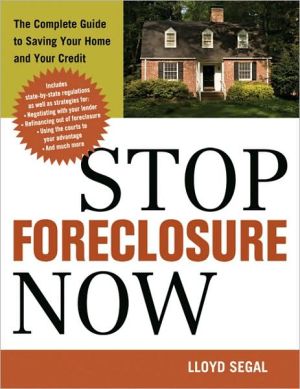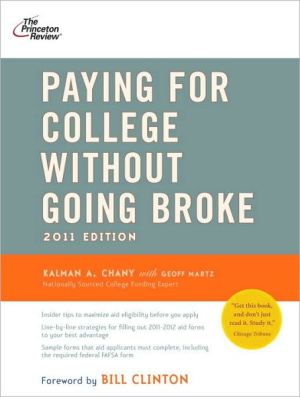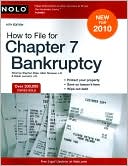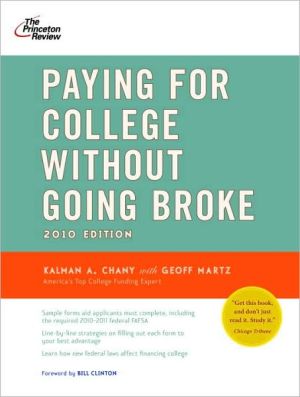Stop Foreclosure Now: The Complete Guide to Saving Your Home and Your Credit
We’ve all heard the reports. Americans are losing their homes in record numbers, and the housing crisis seems unlikely to subside anytime soon. Foreclosures affect all kinds of people and all kinds of properties. Many people faced with foreclosure feel helpless and resigned to giving up their homes without even trying to save them. The good news is that with the right advice, homeowners can take control of the situation, avoid foreclosure proceedings, and even protect their credit. Lloyd...
Search in google:
There are hundreds of books that show investors how to purchase foreclosure properties, but this is the only book that helps people who are in foreclosure. This is the only book that helps homeowners understand the foreclosure process, and explains practical strategies they can utilize to save their homes. This book is required reading for anyone confronting foreclosureForeclosure is not the end of the world - or even the end of your home, necessarily.First, know that you're not alone. Foreclosures affect all kinds of people and all kinds of properties. Like many people faced with foreclosure, you may feel helpless, hopeless, and resigned to giving up your house without trying to save it. If so, cheer up! You actually have some good, solid options to take control of the situation, avoid foreclosure proceedings, and even protect your credit. Depending on which option you choose, Stop Foreclosure Now will help you:* decide whether your property is really worth saving* figure out how much time you have to respond* negotiate with your lender* use the courts to stop the foreclosure * decide whether bankruptcy is a good option* arrange to refinance your property* sell your property quicklyIncludes all the necessary forms and step-by-step instructions.
INTRODUCTION\ A. What Is Foreclosure?\ B. When Will This Book Help You?\ C. What Types of Property Does This Book Cover?\ D. What Types of Foreclosures Does This Book Cover?\ E. Don't Panic.\ F. Can You Really Do It Yourself?\ G. Will This Book Help You If You Do Have an Attorney?\ H. How to Use This Book.\ The experience of falling behind on your loan payments and going\ into foreclosure can be painful, humiliating and stressful. And if you’re like most\ people, your emotional distress is aggravated by a lack of knowledge as you are\ cast into unknown territory. But please be assured--you are not alone. Millions of\ people go into foreclosure every year throughout the United States.\ To minimize your anxiety and maximize your understanding, this book\ provides a thorough discussion of what you will likely encounter once your\ property goes into foreclosure. But before we leap into the fray, there are several\ pointers that you should consider as you start your journey.\ A. What Is Foreclosure?\ Let’s start with a clear definition of “foreclosure.” In its simplest terms, your lender\ has the legal right to sell your property at a public auction if you fall behind on loan\ payments and don’t bring your loan current within a specified period of time. This\ process, known as foreclosure, can be conducted though the court system (judicial\ foreclosure) or without going to court (nonjudicial foreclosure). Depending in\ which state your property is located, you will experience either judicial foreclosure\ or nonjudicial foreclosure. This book covers both.\ Learning the lingo. If you’re facing a foreclosure, you’re going to run into a lot\ of unfamiliar legal terminology. Along the way, this book will try to explain the\ most common jargon in plain English. For a quick reference, you can also check\ the Glossary at the back of the book.\ B. When Will This Book Help You?\ If you are reading this book, there’s a good chance your lender has already\ started foreclosure proceedings. This book will help you understand the\ foreclosure process and figure out what you can do to stop it. But this book\ will also be helpful if you’ve missed payments on a real estate loan and your\ lender is threatening to start foreclosure, or you are struggling to keep current\ on a real estate loan but expect that you won’t be able to keep up the payments\ for much longer. In addition to learning about foreclosure methods, you’ll\ find valuable information on how to negotiate with your lender or use other\ strategies to avoid a foreclosure.\ Your goal should be to learn all you can about foreclosure so you can\ anticipate what might happen and develop a strategy to stop it. This book\ will also help you analyze whether or not to keep your property, by taking\ a long, hard look at your options and deciding which option(s) will ultimately\ be of benefi t to you.\ C. What Types of Property Does This Book Cover?\ In this book, we use the generic word “property” to refer to all types of real\ estate. In other words, the information in this book applies to any real property,\ regardless of whether you own a single-family home, condominium, duplex,\ triplex, apartment building, shopping center, offi ce building, commercial\ building, industrial park or raw land.\ D. What Types of Foreclosures Does This Book Cover?\ This book covers foreclosure by a lender who holds a written lien against your\ property (called a “mortgage” or “deed of trust”) as security for repayment\ of its loan. This lender could be the financial institution that originally gave\ you a loan to purchase your property, or a lender who subsequently lent\ you additional money also backed by security in your property (such as a\ bank that granted you a home equity loan), or the lender that refi nanced your\ property, or the seller of the property who accepted a portion of the sale’s\ price in the form of a junior lien, or a company that subsequently purchased a\ loan from any of your original lenders.\ Foreclosures not covered by this book. This book does not cover tax sales, court\ judgments, or mechanic’s lien sales, which are not technically foreclosures.\ If you are involved with any of these forced sales, you should consult an\ a_orney. Nevertheless, many of the strategies described in this book can\ be applied to these involuntary sales as well.\ ICONS USED IN THIS BOOK\ Throughout this book, we have included special icons to help organize the\ material and underscore particular points:\ --Legal or common sense tips to\ help you understand or comply with\ legal requirements.\ --A caution to slow down and\ consider potential problems.\ --A suggestion to seek the advice of\ a lawyer, tax advisor or other specialist.\ --An indication that you may be\ able to skip some material that does not\ apply to you.\ --A cross-reference to another section of\ this book, or a suggestion to consult\ another book or resource.\ E. Don’t Panic\ Property owners in foreclosure are like deer caught in the headlights of an\ approaching automobile. Panicked, they freeze with inaction. Misunderstanding\ the process, they o_en use the word “foreclosed” in the past tense as though\ they have already lost their property.Or worse, some people assume their\ properties are already lost and move out without even pu_ing up a fight. Don’t\ let this happen to you!\ Although easier said than done, it is important not to panic simply\ because a foreclosure has started. As you will learn in this book, foreclosure\ is a lengthy process--not a single event. The process takes a minimum of three\ months in some states (nonjudicial foreclosures), and as long as one to\ two years in other states (judicial foreclosures). Additionally, in a judicial\ foreclosure, you may have the right to buy back (“redeem”) your property\ for an additional period a_ er the foreclosure sale depending on the laws\ in your state.\ So, whatever you do, don’t think all is lost and give up without a fi ght.\ You still have time to develop and implement a plan to stop the foreclosure,\ and this book will help you.\ F. Can You Really Do It Yourself?\ Unless your foreclosure is unusually complex, the answer is yes--a\ resounding yes! You simply need to use your common sense, the willingness\ to learn about foreclosure procedures, and the commitment to deal with your\ lender. In other words, your everyday life experiences are the foundation of\ what you need to know.\ For the most part, the techniques described in this book do not require\ legal knowledge. Forget the notion that you have to act or sound like an\ experienced lawyer to be successful in dealing with lenders. As you will\ discover, the vast majority of people you’ll deal with during the foreclosure\ will not be lawyers.\ Realize that no matter how many times you read this book and how\ carefully you prepare, you will probably be nervous when you fi rst approach\ your lender, trustee or sheriff. But, rest assured, you’re not the only one feeling\ uneasy. Most people (including lawyers) feel anxious when they begin a new\ task.\ So take a deep breath and gather up your courage. As long as you\ combine your common sense with the principles and techniques described\ in this book, and are not afraid to ask people questions if you need help, you\ should be able to represent yourself competently and effectively.\ G. Will This Book Help You If You Do Have an Attorney?\ Finally, if an attorney already represents You, this book can still help you. Keep\ in mind that your property belongs to you--not your lawyer. Based upon\ this simple fact, no lawyer will ever be able to give as much attention to\ stopping your foreclosure as you can.But, a good lawyer can do a better\ job of representing you if you are informed and knowledgeable about the\ foreclosure process and can participate in making critical decisions.\ H.How to Use This Book\ This book is designed to increase your overall understanding of the foreclosure\ process (including procedures and strategies that may initially seem\ peculiar or foreign), and to provide specific techniques you can use to stop\ the foreclosure. Here’s the best way to use this book.\ Step 1. Read Chapter 1 and Decide Whether or Not to Keep Your\ Property\ Chapter 1 orients you to the world of foreclosure law and helps you decide\ whether to keep your property. Based on your decision, you’ll begin to develop\ a plan to stop foreclosure in Chapter 1, Section E.\ If you’re in the midst of a foreclosure. If you do not have the time to read large\ portions of this book, read Chapter 1, then proceed to those method(s) of\ dealing with foreclosure that apply to your particular situation.\ Step 2. Learn About the Legal Documents Underlying a\ Foreclosure\ Chapter 2 explains the underlying documents in a foreclosure: the\ promissory note and deed of trust, or the mortgage. Understanding these\ documents, which you signed when you obtained your loan, is fundamental to\ dealing with foreclosure.\ Step 3. Read About the Kind of Foreclosure You’re Facing\ There are two kinds of foreclosures:\ • judicial--where the lender files\ a lawsuit in court to foreclose a\ mortgage.\ • nonjudicial--where the lender uses\ a trustee to follow an out-of-court\ procedure to foreclose on a deed of\ trust.\ Each type of foreclosure follows different procedures, and you need to be\ concerned only with those procedure that apply to your particular state. If\ lenders in your state use mortgages to secure real estate loans, then most likely\ the foreclosure will be judicial, covered in Chapter 4. If, on the other hand,\ lenders in your state use deeds of trust to secure real estate loans, then most\ likely the foreclosure will be nonjudicial, covered in Chapter 3. (If you don’t\ know which kind of foreclosure applies to you, look up your state in the\ Appendix in the back of this book.)\ Step 4. Pursue Strategies to Stop Foreclosure\ Depending on whether you’ve decided to keep or give up your property, you\ need only read those chapters with strategies that interest you. Chapter 1,\ Section E, summarizes your options and refers you to the appropriate chapters.\ (Chapters 5 through 9 describe strategies to keep your property. Chapters 10 and\ 11 cover strategies to get rid of your property.)\ Step 5. Seek Additional Help If You Need It\ In Chapter 12, you’ll learn how to find a lawyer or foreclosure consultant to\ help you. Chapter 12 also gives helpful information on doing your own legal\ research.
INTRODUCTIONA. What Is Foreclosure? B. When Will This Book Help You? C. What Types of Property Does This Book Cover? D. What Types of Foreclosures Does This Book Cover? E. Don't Panic K Can You Really Do It Yourself? G. Will This Book Help You If You Do Have an Attorney? H. How to Use This Book CHAPTER 1DEVELOP A PLAN TO STOP FORECLOSUREA. Communicate With Your Lender B. Get Organized C. Learn the Clock D. Decide Whether or Not to Keep Your Property E. Develop a Plan of Action CHAPTER 2UNDERSTANDING THE DOCUMENTS UNDERLYING A FORECLOSUREA. Promissory Note B. Deed of Trust C. Mortgages D. Reviewing Your Deed of Trust or Mortgage CHAPTER 3NONJUDICIAL FORECLOSURESA. Overview of Nonjudicial Foreclosure B. Notice of Default and Election to Sell C. The Reinstatement Period D. Notice of Trustee's Sale E. The Redemption Period F. Trustee's Sale CHAPTER 4JUDICIAL FORECLOSURESA. Why Lenders Choose Judicial Foreclosures B. Overview of a Judicial Foreclosure CHAPTER 5NEGOTIATING WITH YOUR LENDERA. Negotiating Strategies B. Negotiating With an Institutional Lender C. Negotiating With a Private Lender D. Negotiating With HUD and the FHA E. Negotiating With the U.S. Department of Veteran Affairs CHAPTER 6REFINANCING OUT OF FORECLOSUREA. Deciding Whether to Refinance B. Should You Use a Mortgage Broker? C. Will You Qualify for Refinancing? D. Overview of Refinancing E. Kinds of Loans F. How to Find a Lender to Refinance Your Property G. Closing CostsCHAPTER 7USING YOUR MILITARY STATUS TO STOP FORECLOSUREA. Are You Covered by the SSCRA? B. How to Use the SSCRA to Reduce Your Interest Rate and Payments C. How to Use the SSCRA to Stop a Nonjudicial Foreclosure D. How to Use the SSCRA to Stop a Judicial Foreclosure CHAPTER 8USING THE COURTS TO STOP A NONJUDICIAL FORECLOSUREA. Do You Have Grounds to Go to Court? B. Overview of a Lawsuit to Enjoin Foreclosure C. How to File a Lawsuit and Get a Temporary Restraining Order D. How Your Case Proceeds After the TRO Hearing CHAPTER 9BANKRUPTCYA. File for Bankruptcy and Stop the Foreclosure B. How Bankruptcy Works C. Which Bankruptcy Is Right for You? D. Additional Resources . CHAPTER 10HOW TO SELL YOUR PROPERTY QUICKLY TO STOP FORECLOSUREA. Deciding Whether to Sell Your Property B. Hire a Real Estate Agent C. Implement a Plan to Sell Your Property D. Prepare Your Property for Sale E. Offers and Counter-Offers F. Proceeding Through to Closing G. Special Rules for Dealing With Equity Purchasers H. Arranging a "Short Sale" With Your Lender CHAPTER 11GIVING YOUR LENDER A DEED IN LIEU OF FORECLOSUREA. Reasons to Use a Deed in Lieu B. Will Your Lender Accept a Deed in Lieu? C. Negotiate Terms of the Deed in Lieu D. How to Prepare a Deed in Lieu of Foreclosure CHAPTER 12HELP BEYOND THIS BOOKA. Real Estate Lawyers B. Using a Foreclosure Consultant C. The Law Library, Internet, and Legal Research APPENDIXGLOSSARYSUMMARY OF STATE FORECLOSURE LAWSTECHNICAL SUPPORT








